Schwann Cell
Introduction
Schwann cells, also known as neurolemmocytes, are a variety of glial cells that keep peripheral nerve fibers alive. In the peripheral nervous system (PNS), they are the principal glia. They are named after physiologist Theodor Schwann, who discovered them in the 19th century.
Structure and Function
Schwann cells are responsible for the formation of myelin sheath around the axons of the peripheral nerves. The myelin sheath not only insulates the nerve fibers but also increases the speed of electrical impulses (action potentials) along the nerve fibers. Schwann cells are also involved in the maintenance of the ionic environment of the nerve fibers, modulation of nerve impulse transmission, and regulation of the synaptic transmission.


Development
Schwann cells originate from the neural crest cells during embryonic development. The neural crest cells migrate to the developing peripheral nerves where they differentiate into Schwann cells. The process of myelination begins during the late embryonic stage and continues postnatally.
Types of Schwann Cells
There are two types of Schwann cells: myelinating and non-myelinating. Myelinating Schwann cells wrap around the larger nerve fibers forming a myelin sheath. Each myelinating Schwann cell myelinates a single internode of one axon. Non-myelinating Schwann cells, on the other hand, ensheath multiple small diameter axons but do not form a myelin sheath.
Role in Nerve Regeneration
Schwann cells play a crucial role in the regeneration of nerve fibers in the peripheral nervous system. When a nerve fiber is damaged, the Schwann cells aid in the clearance of the axonal debris and guide the regrowth of the nerve fibers. They also secrete various growth factors that promote nerve regeneration.
Pathology
Schwann cells are involved in several neuromuscular diseases. In Charcot-Marie-Tooth disease, mutations in the genes that code for proteins involved in the function of Schwann cells lead to a progressive loss of muscle tissue and touch sensation. Schwannomas and neurofibromas are tumors that arise from Schwann cells. Schwann cells also play a role in the pathogenesis of inflammatory neuropathies such as Guillain-Barré syndrome.
Research and Future Directions
Research on Schwann cells has increased our understanding of the peripheral nervous system and has potential implications in the treatment of various neuromuscular diseases. Future research directions include understanding the molecular mechanisms of Schwann cell function and their role in nerve regeneration, developing therapeutic strategies for diseases involving Schwann cells, and exploring the potential of Schwann cells in nerve repair and regeneration.
